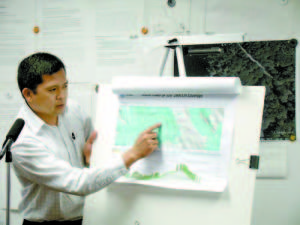AT&T refutes co-location argument

RIDGE IN THE WAY — AT&T Radio Frequency Engineer Ernesto Chua points out a ridge on the east side of the existing 130-foot-tall U.S. Cellular tower on Sam Ingalls Road. He said the ridge would obstruct RF signals sent from the top of the tower from reaching AT&T’s proposed coverage area on Route 302, therefore eliminating it as an alternative site to AT&T’s proposed new cell tower on Hio Ridge Road.
(Geraghty Photo)
By Gail Geraghty
Staff Writer
An engineer for AT&T put to rest Tuesday the contention by Hio Ridge Road residents that the company could meet its coverage needs by co-locating an antennae on an existing cell phone tower on Sam Ingalls Road.
Put simply, a ridge between the 130-foot-tall Sam Ingalls tower and east to Route 302 blocks the line of sight, said AT&T Radio Frequency Engineer Ernesto Chua. Even if AT&T extended the tower height to 200, 300, or 400 feet — well beyond what’s acceptable — the ridge would still be in the way, added AT&T spokesperson Barry Hobbins.
Hio Ridge Road resident Paul Veit, however, pointed out that AT&T’s application for a new tower at 214 Hio Ridge Road specifically stated that the signal needed to run west, not east. By sending the signal west, Veit said, “It’s a straight shot.â€
Hobbins denied Veit’s claim, saying “It’s not specific. It’s not.â€
The debate began as Hobbins asked the board to hear from Chua, who researched multiple sites before concluding that the Hio Ridge Road property would best meet AT&T’s coverage needs. The board has yet to hear from the independent third-party consultant who is reviewing Chua’s work, but Hobbins said “It’s important to know the due diligence that AT&T has done†to investigate the possibility of co-locating on the Sam Ingalls Road tower.
“The major focal point of this whole issue is whether Sam Ingalls is appropriate,†Hobbins said. “There’s been a lot of accusations made that we haven’t talked to U.S. Cellular†about using their tower, which are false, he said.
Veit said the major debate is over the feasibility of co-location. “The (Tower) Ordinance doesn’t say that if you can get a slightly better sliver of coverage, you get a new tower,†he said. The ordinance requires applicants to only consider a new tower if no existing tower provides a feasible location.
Chua said he spoke once to the independent consultant from IDK Communications in order to explain his methodology, but has had no further contact. IDK, Ransom Consulting Engineers and Scientists and Terrence DeWan & Associates have until Aug. 26 to issue their findings, but Bridgton Economic and Community Development Director Anne Krieg said she expects the reports to be delivered to the board by their regular meeting on Tuesday, Aug. 5.

